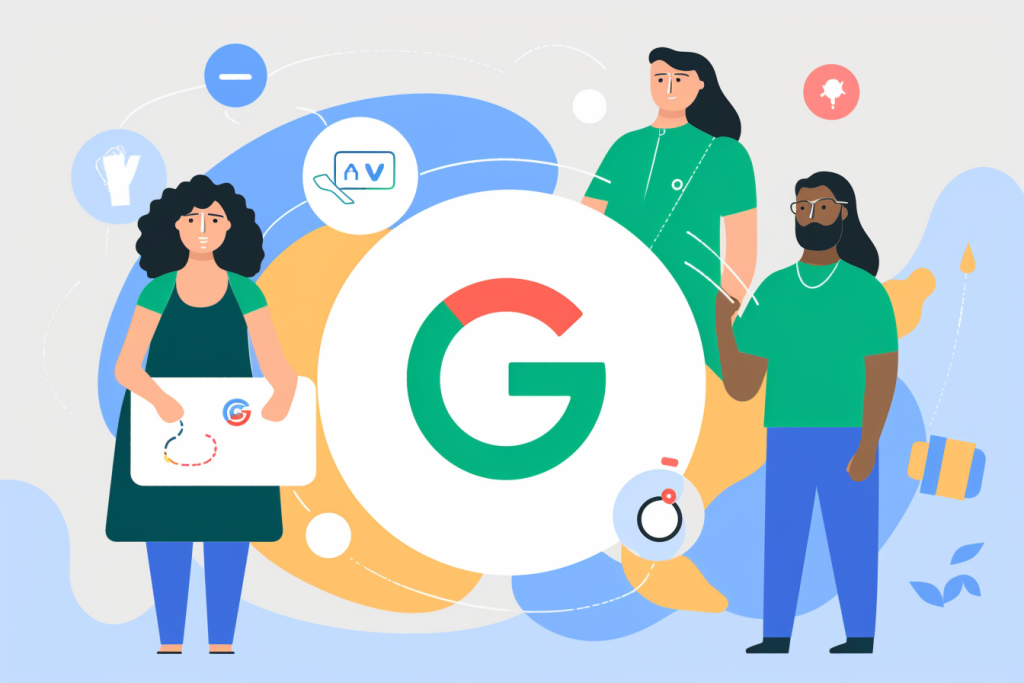As we navigate the ever-changing world of digital marketing, we need to recognize and cater to the diverse needs of our audience. In the senior care industry, this means understanding that many individuals requiring our services come from various cultural backgrounds and speak multiple languages.

It’s not enough to solely target English-speaking audiences; we must create inclusive campaigns that resonate with multilingual communities. Doing so, we’ll be better equipped to serve those in need while expanding our reach and impact.
This article will dive deep into targeting multilingual senior care audiences using Google Ads. We’ll discuss strategies for identifying your target audience, setting up multilingual ad campaigns, optimizing ad copy for different languages, leveraging Google Ads’ targeting features, and monitoring and optimizing your campaigns for success.
By implementing these techniques thoughtfully and effectively, you can ensure your ads resonate with a broader range of potential clients – ultimately fulfilling your desire to provide exceptional care for those who need it most.
Understand Your Target Audience
Grasping the essence of your diverse clientele is crucial for crafting tailored ad campaigns that resonate effectively. As we strive to target multilingual senior care audiences in Google Ads, understanding our audience’s unique needs and preferences is critical.

To do this, we must approach our marketing efforts with cultural sensitivity and a keen awareness of any language barriers within our target demographic. By acknowledging these factors, we can create targeted ads that communicate our message clearly and demonstrate empathy and respect for the individuals we aim to serve.
To fully understand our target audience, we must dive deep into their backgrounds, experiences, and expectations regarding senior care services. This involves researching cultural nuances that may influence their decision-making process and identifying commonalities among different linguistic groups.
We must stay detail-oriented as we analyze data on age demographics, geographic locations, preferred languages, and family dynamics within each community we hope to reach. By doing so, we foster an inclusive environment in which all members of our multilingual audience feel valued – ultimately leading to more effective Google Ads campaigns that cater specifically to their needs while fulfilling our collective desire to serve others.
Set Up Multilingual Google Ads Campaigns
Don’t worry about reaching diverse elderly communities; setting up multilingual ad campaigns will be a breeze once you know the steps.
We first need to create a list of relevant multilingual keywords that resonate with our senior care audience in their native languages. This way, we can increase the chances of our ads being seen by those searching for senior care services in their preferred language.
Additionally, it’s essential to utilize ad scheduling so that our advertisements appear during peak hours when our target demographic is most likely to be active online.
Create separate ad groups for each language and target location to set up an effective multilingual Google Ads campaign. This approach allows us to tailor the ad copy and landing pages specifically for each audience segment while ensuring that the right message reaches them at the right time.
Don’t forget to monitor your campaigns regularly and optimize based on performance data, such as click-through and conversion rates. By staying detail-oriented and constantly refining our strategies, we’ll make sure that our Google Ads efforts not only reach but also effectively engage with diverse elderly communities needing quality senior care services across different languages and regions.
Optimize Your Ad Copy for Different Languages
You’ve got this! Crafting the perfect ad copy for each language can make a difference in connecting with those communities and showcasing your top-notch services. By focusing on language adaptation and considering cultural nuances, you’ll create an inclusive experience that resonates with your multilingual senior care audience.

Remember, it’s not just about translating words; it’s about conveying the right message and emotions to evoke trust and compassion.
To ensure that your ads are adequate across different languages, consider these key aspects:
- Language Adaptation: Tailor your ad copy to suit the linguistic preferences of each target audience. This means using idioms, expressions, or slang popular in their culture to make the content more relatable.
- Cultural Nuances: Understand cultural norms and expectations when crafting ads for different markets. For example, some cultures prefer indirect communication, while others value straightforward messaging. Knowing these differences will help you prepare ads that resonate better with each group.
- Localized Imagery: Visuals play a significant role in advertising, so choose images reflecting local culture and customs for a more authentic connection.
By being analytical, detail-oriented, and inclusive in crafting multilingual ads for senior care services, we can provide an engaging experience tailored to our diverse audience’s needs. This will showcase our dedication to serving others and help build stronger relationships within these communities.
To optimize your ad copy for different languages and watch your multilingual senior care campaign thrive!
Leverage Google Ads Targeting Features
Unlock the full potential of your advertising strategy by harnessing the power of Google Ads’ advanced targeting features, designed to pinpoint and captivate your diverse clientele in the senior care realm. As you tailor your campaigns for multilingual audiences, leveraging these powerful tools for maximum impact is essential. By conducting thorough keyword research and ad localization efforts, we can ensure that our ads resonate with our target demographic while maintaining a consistent brand voice.
To make the most out of these Google Ads features, let’s dive into some key components that will help us fine-tune our targeting:
| Component | Description | Example |
|---|---|---|
| Location Targeting | Reach customers in specific countries, regions, or cities where your senior care services are offered. | Target ads in California and Florida. |
| Language Settings | Match your ads with users of a specific language based on their Google account settings. | Spanish-speaking users in Texas. |
| Demographic Targeting | Display ads based on age group or gender preferences relevant to your senior care audience profile. | Female users aged 65+. |
| Audience Interest Categories | Show ads to users who have demonstrated interest in topics related to elderly care and caregiving. | Users are interested in home healthcare. |
| Remarketing Lists | Re-engage previous website visitors or app users with tailored messaging for better conversion rates. | Remind visitors about an open house event at a local senior living community. |
Incorporating these elements into our campaigns allows us to reach potential clients from various linguistic backgrounds while ensuring our message resonates with their unique needs and preferences within the senior care sector. By diligently applying keyword research and ad localization best practices, we can create an inclusive advertising strategy that effectively serves all members of our diverse target audience: seniors, caregivers, family members, and professionals.
Monitor and Optimize Your Multilingual Ad Campaigns
Keeping a close eye on your various ad campaigns and adjusting as needed is crucial, ensuring that each language group is effectively engaged and captivated.
Monitoring and optimizing your multilingual ad campaigns involve a continuous ad performance analysis and keyword research process, which helps you identify the best-performing ads and keywords for each target language. This way, we can allocate our resources more efficiently, maximizing ROI while delivering valuable content to our senior care audience.
To make the most out of our multilingual Google Ads campaign, let’s focus on these critical areas:
- Ad Performance Analysis:
- Evaluate metrics like click-through rate (CTR), conversion rate, cost per click (CPC), and return on ad spend (ROAS) for each language segment.
- Identify top-performing ads regarding engagement and conversions, then optimize underperforming ones by refining their messaging or targeting parameters.
- Keyword Research:
- Monitor search queries that drive traffic to your website from different language groups.
- Discover new keywords relevant to your senior care services by analyzing user intent in various languages.
By staying detail-oriented and inclusive in our approach to monitoring and optimizing multilingual ad campaigns, we can better serve the diverse needs of seniors from various cultural backgrounds.
As a result, we’ll be able to reach out more effectively to those who need our assistance – fulfilling their subconscious desire for support while achieving tremendous success in our marketing endeavours.
Frequently Asked Questions
How do you address the cultural differences and sensitivities when targeting multilingual senior care audiences in Google Ads?
In addressing cultural differences and sensitivities when targeting multilingual senior care audiences, we prioritize cultural sensitivity and overcoming language barriers.
We understand the importance of acknowledging diverse backgrounds and beliefs and fostering an inclusive environment catering to individual needs.
By thoroughly researching various cultures represented within our target audience, we can craft tailored messages that resonate with them.
Additionally, we strive to break down language barriers by collaborating with experts fluent in multiple languages or utilizing translation services. This ensures that our communication is clear, accurate, and culturally appropriate for our communities.
By being analytical, detail-oriented, and empathetic, we can create meaningful connections with seniors from different backgrounds while fulfilling their desire for compassionate care.
When targeting multilingual senior care audiences, how do you effectively allocate your budget across various languages and regions?
As we navigate language barriers and regional regulations, we must effectively allocate our budget across various languages and regions for optimal impact.
We can prioritize resources and adapt our strategies by assessing the market size, local competition, and potential growth in each target area.
It’s essential to consider both the linguistic preferences of our senior care audience and any regulatory nuances that may differ between locations.
This inclusive approach ensures that we reach a diverse range of clients and cater to their unique needs with sensitivity and understanding.
By maintaining this balance in our allocation efforts, we demonstrate our commitment to serving others while promoting an environment where all seniors feel valued, regardless of language or location.
What are some common challenges or pitfalls when running Google Ads campaigns for multilingual senior care audiences, and how can they be overcome?
When tackling common challenges like language barriers and ad personalization in reaching multilingual senior care audiences, we must be mindful of cultural nuances and preferences to create an inclusive and effective campaign.
By investing time in understanding the unique needs of various audiences and employing translation services or native speakers for accurate translations, we’ll ensure our message resonates with everyone.
Additionally, segmenting campaigns by language and region allows for better budget allocation, targeting specific demographics within each market.
Let’s work together to make a real difference in people’s lives by providing tailored solutions that address their needs while fostering a sense of belonging in our diverse community.
How can you maintain consistent messaging and branding across different languages and cultures in your Google Ads campaigns targeting multilingual senior care audiences?
Navigating language barriers and cultural nuances can be tricky, but it’s essential for maintaining consistent messaging and branding across different languages and cultures. To achieve this, we’ll need to collaborate with native speakers who understand the subtleties of each language and bring them on board as translators or consultants.
They’ll help us adapt our campaigns to resonate with our multilingual senior care audiences while preserving our core brand values and identity. By being attentive to language-specific idioms, expressions, and cultural references, we can create engaging content that speaks directly to the hearts of our diverse audience.
This approach fosters trust, loyalty, and a sense of belonging among those who rely on us for their senior care needs.
What role does website and landing page localization play in the success of a multilingual Google Ads campaign targeting senior care audiences?
Imagine running a successful multilingual Google Ads campaign for a senior care facility in California, where we cater to a diverse range of clients, including English, Spanish, and Chinese-speaking seniors.
To effectively reach these varied audiences, our website and landing pages must be translated and localized to address the cultural nuances specific to each language group. By incorporating localized keywords and taking into account the unique cultural aspects of our target demographics, we can create an engaging user experience that resonates with potential clients on a personal level.
This attention to detail helps build trust between our brand and its diverse audience – ultimately leading to higher conversion rates and a more successful multilingual Google Ads campaign targeting senior care audiences.
Conclusion
In conclusion, we’ve seen how crucial it is to target multilingual senior care audiences in our Google Ads campaigns. We can effectively reach this diverse market by understanding our audience, setting up multilingual campaigns, optimizing ad copy, leveraging targeting features, and monitoring performance.
Did you know that seniors who speak multiple languages have a significantly lower risk of developing dementia? Let’s ensure our ads cater to this incredible group and provide them with the best care options.



